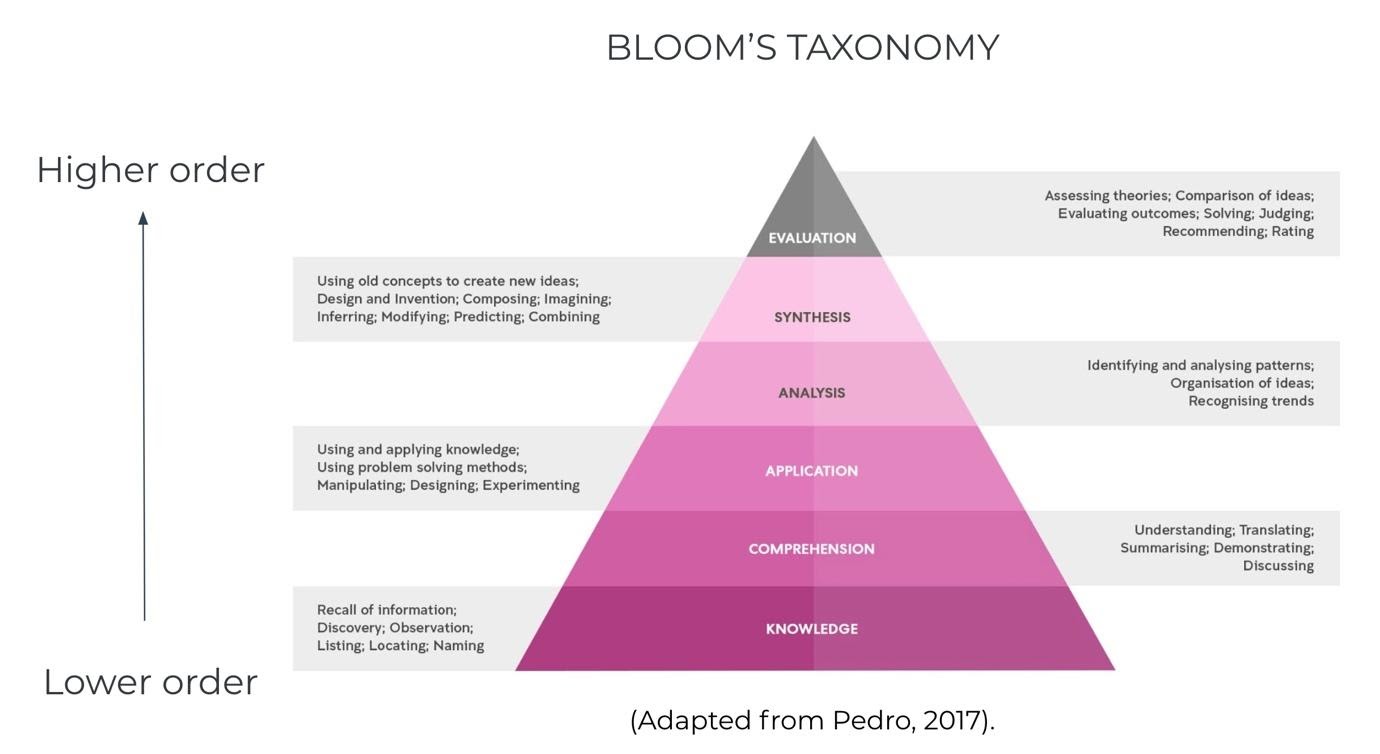Thought-provoking and higher order questions not only inspire a deeper understanding but can encourage and promote the transfer of knowledge. So how do we distinguish higher and lower order questions? And how can we use higher order questions in eLearning? Bloom’s taxonomy is a great place to get started.
What is Bloom’s Taxonomy?
In 1956, Benjamin Bloom published a framework for categorising educational goals, which you can see in the pyramid below. Each category is designed to increase the cognitive demand of the learner gradually. Lower order questions are at the base of the pyramid and generally consists of knowledge and comprehension style questions. Higher order questions emerge as you move upwards. Higher order questions will encourage the learner to apply, analyse, synthesise, and evaluate.

What sort of questions appear in each category?
At the knowledge and comprehension level, the learner is expected to identify and recall information (knowledge) and organise and select facts or ideas (comprehension). These questions usually begin with a who, what, when, where, how, describe, retell, or summarise.
At the application level, we start to see the transfer of knowledge. Application style questions expect the learner to use facts, rules and principles. These questions might be:
-
How is… an example of…?
-
How would you use…?
-
What approach could you use to…?
-
Which of the following can be applied to the following scenario?
Analysis will require the learner to break down the content into parts by describing patterns and organising information. These questions might be:
-
What is the relationship between…?
-
How does… compare/contrast with…?
-
Classify… according to…
Synthesis is about using and combining concepts to create a new idea. Learners are asked to arrange, create, design, or predict. And finally, evaluation is about developing an opinion and forming a judgement. The learner could be asked to assess, determine, evaluate, or justify.
A combination of these different questions is ideal, and learning designers should reflect and consciously audit their questions. Are your questions challenging? Are you varying the cognitive demand?
You could start by turning a lower order question into a higher order question. For example, instead of asking the learner to identify which country has the lowest literacy rate (knowledge), you might ask the learner to compare the literacy rates of different countries (analysis) or propose an intervention that could help increase literacy rates (evaluate).
Which question types work best for higher order thinking in e-learning?
Most e-Learning modules will feature a variety of question types such as essay/short answer, multiple response, multiple choice, fill-in-the-blank, matching, and true/false or yes/no. But not all of these question types can be used at the higher level, and some work better than others for different cognitive demand levels.
True/false and matching questions generally work best for lower order thinking (knowledge and comprehension). Fill-in-the blank questions can be a great option for application, and multiple choice and multiple response questions are possible for analysis. Synthesis and evaluation will generally require open-ended, short answer, or essay style questions.
In your next e-Learning module, you might like to stick with true/false and matching questions for knowledge and comprehension. Fill-in-the-blank questions can then be used for application, and multiple choice and multiple response questions could be used for analysis. This can help vary the cognitive demand of your learners and stop you from using multiple choice questions for all cognitive levels.
Gradually increasing the cognitive demand of your learners will help them feel more capable as the complexity increases. Planning where you place your questions is important. For example, you may like to limit true/false questions to the start of your module when you are building the learner’s knowledge and comprehension. You can then begin to increase the cognitive demand of your learners by using more multiple choice questions towards the end when they need to apply what they have learnt.
Plan carefully where your questions will go, vary the cognitive demand by selecting questions from a variety of Bloom’s categories, and make sure you have a range of question types to keep the learner engaged and interested.

.png)

